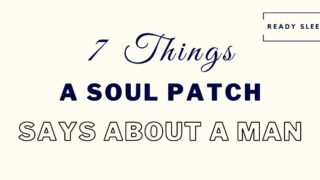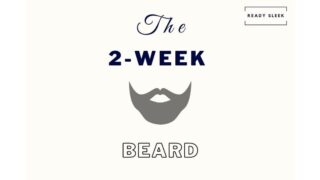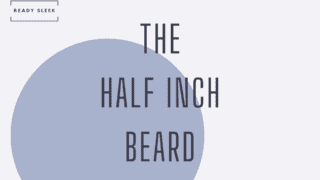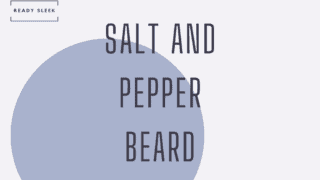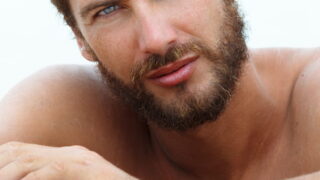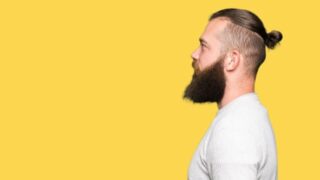One day you’ll get to a point where beard brushing becomes essential. But knowing how to do it effectively is crucial. You’re about to learn exactly how to brush your beard the right way.
Simplifying the process is important.
Breaking it down to the key components that actually make a difference and learning how to do those things properly will always serve you well.
But as with any aspect of beard grooming, learning how to brush your beard incorrectly will lead to more harm than good.
So, let’s get to it.
How To Brush Your Beard In 7 Steps
You may not be able to follow this exact, step-by-step approach each and every time. But when you’re able to, you’ll notice your beard looking healthier and happier right from the outset.
After 3 to 4 weeks of growth, your beard will get to a point where it’ll benefit from effective beard brushing. Follow this routine for excellent results.
1. Gather Your Tools
A beardsman without the right tools at his disposal is destined for failure.
That may sound overly dramatic, but it’s kind of true. The good news is, you really don’t need much.
Here’s a list followed by a brief explanation:
- A boar bristle beard brush
- Beard oil
- Possibly a styling product eg. beard balm or wax
As you’d expect, the most important tool you’ll need is a beard brush. But not all of them are made equal.
Choose a boar bristle beard brush over a synthetic brush each and every time. Boar hair is similar to beard hair in texture, so it glides effortlessly through it with minimal tugging and damage.
Boar Bristle Beard Brush –
Synthetic brushes, although a little cheaper, do more harm than good in the long run.
Finally, a styling product to use after the brushing session may be necessary.
A product with some level of hold like balm or wax can tame stray hairs and also keep more complex styles in place throughout the course of the day.
2. Plot Your Brushing Direction
Beard brushing direction is so important.
Brushing in the wrong direction leads to untidiness – the beard will be trained to grow in the wrong direction over time.
Brushing in the right direction leads to a disciplined beard that’s been tamed over weeks and months.
As a general principle, brush downward towards your chin for the best outcome.
The reason for this is that you’ll usually want to brush your beard with the grain. In other words, in the direction of growth.
For the most part, this means downward for the cheek beard, fore beard, and mustache.

The neckbeard is the hair behind the fore beard that as the name would suggest, forms a layer over the neck.
Brushing this area under the chin is a little bit harder because hair can grow in all sorts of directions here. Brush this area last – I’ll come onto this shortly.
So, to sum this up, your cheek beard should be brushed either diagonally downward toward the chin or vertically downward. The mustache and fore beard should usually be brushed downward.
Visualize these directions in your mind before you brush and while you brush.
3. Start Brushing At The Cheeks
Before you start brushing in these directions, it’s often helpful to brush your entire beard upward first.
This may sound odd, and the fluffy mane you’ll be left with will certainly look odd. But don’t worry as it’s only temporary.
Doing this will detangle some tangled hairs and will also give you a better idea of exactly what you’re working with.
Once you’ve done this, start brushing in the desired directions as explained above. Starting at the cheeks and working your way downward is a good option.
When brushing, be firm but not rough. If you feel a little tugging or pulling, adjust your angle and be gentle to avoid pulling out hairs prematurely.
The boar hair bristles should glide through the beard with little to no fuss. It’s a glorious experience.
Brush your cheek beard and fore beard before moving onto the mustache.
Some men may prefer to use a specific mustache comb for the mustache but this is down to personal preference.
Brush the mustache downward and look out for any stray hairs that creep over the upper edge of the top lip.
This can look untidy, so you may want to take this opportunity to trim or cut them at this point.
Once you’ve done this, it’s time to tackle the neckbeard.
4. Tackle The Neckbeard
The “neckbeard” lies behind the fore beard, giving it support and volume.
It’s important to keep it well maintained because as it grows downward toward your chest it can look increasingly unsightly.
This is why it’s so important to keep your beard neckline (the border between your neckbeard and your neck skin) well-defined.
As I mentioned earlier, the reason it’s difficult to brush the neckbeard is that the hair tends to grow in multiple different directions.
Here’s a full tutorial on how you can hone the art of brushing your neckbeard.
But the cliff notes are that it really depends on your growth distribution and your preferences.
Brushing the neckbeard upward toward the chin can give the fore beard more support and more volume. However, this is usually going against the grain and may lead it to looking untidier than you may like.
Try brushing it down instead to see if you prefer it. As long as the neckline is well-defined and trimmed, it should look neat.
You could also try brushing it downward and backward, as this often (generally) with the grain.
Try out these three options to see what you prefer. There’s no obvious or right or wrong answer with this one.
5. Consider Applying Some Styling Product
This would be a good idea if you find that your beard looks neat immediately after you brush it and for a short while after, but it gradually becomes untidy over the course of the day.
Grooming products such as beard oil are great but they lack one potentially important feature; hold.
It can’t keep hairs in place as it doesn’t have a level of hold.
Products such as beard balm and beard wax, on the other hand, do have a level of hold and can keep stray hairs in place. They’re also great for holding more complex beard styles in place.
Beard balm has a nice, subtle, gentle level of hold, so is great if you’re looking for something simple.
But if you’ve got particularly thick beard hair or you’ve got an especially complex style, beard wax may be necessary.
If you think you’d benefit from some product, use it.
At this point, you can safely say you’ve brushed your beard to perfection.
Key Benefits Of Brushing Your Beard
Now that you’ve learned exactly how to brush your beard properly, it’s time to get a good understanding of why you need to do it in the first place.

1. It Tames The Beard
What I mean by this is that it guides the beard hair to grow in your desired direction.
Beards are notoriously stubborn in the way they grow initially. They just don’t like to play ball and it’s an endless source of frustration for beardsmen.
They tend to grow in all sorts of directions; this looks untidy and patchy.
But over time, a beard can be tamed by brushing it. It coaches the beard hair to grow in a certain direction – downward is usually desirable.
It takes time, but the results are worth it. After a couple of months, you’ll probably notice that your beard hair looks straighter, flatter, and more uniform in direction.
It’s great because the overall result is that the beard looks fuller.
You’ll find that you actually need to brush your beard less frequently because it’s more likely to behave itself.
2. It Distributes Oils
I touched upon this earlier, but it’s worth noting here as well.
Whether it’s natural sebum or artificial beard oil, the bristles of a boar bristle beard brush are fantastic for distributing it evenly.
It prevents it from accumulating.
Common Beard Brushing Mistakes To Avoid
These are mistakes that can actually do some damage, so do your best to avoid them.
1. Using A Synthetic Beard Brush
Synthetic bristles can wreak havoc on beard hair.
It can be tempting to go for a synthetic beard brush at times, as they’re often significantly cheaper.
But if you were going to invest in one proper beard grooming tool, a boar bristle beard brush would be an excellent choice. It’s pretty essential.
The texture of synthetic bristles isn’t as kind to beard hair; you’ll find that tugging, pulling, and irritation is more of a problem.
Plus, you won’t get the same benefits. Synthetic bristles just aren’t as good at distributing oils and flattening beard hair.
It’s less effective in several different ways.
Although this is debatable, you could say that not brushing at all would be less harmful than brushing with a synthetic beard brush.
Actively doing damage is worse than not doing anything at all.
2. Being Too Aggressive
We’ve all been there.
Life gets in the way of giving your grooming regimen the proper time and attention it deserves.
Let’s face it – people are in a rush sometimes.
This can lead to hasty and quick beard brushing. Aggressive beard brushing can do damage for a couple of reasons.
One is that the
Another reason is that you won’t be paying enough attention to what you’re doing. You won’t be making as much effort to brush in the correct directions or with the correct amount of force.
It’s easier said than done at times, but when you’re brushing your beard, try not to rush. Enjoy the experience, take your time, and focus.
3. Doing It Too Regularly
This is a common mistake, especially when you just start doing it and the novelty hasn’t quite worn off yet.
For most men, making a point to brush their beard once a day would be a good habit to form. No more and no less.
Frequently Asked Questions
Here are a couple of FAQs to round things up.
Do I Need To Comb My Beard As Well?
It depends on the length. A beard comb should be added to your grooming kit at around 3 months of growth.
Before this point, a beard brush alone should be enough. But eventually, the bristles of a brush will be too short to tackle the tangles and clumps of the deeper beard hair.
Brushing and combing go hand in hand, and they’ve both become pillars of modern beard grooming.
Brushing is better at taming beard growth direction and also re-distributing oils.
Combing is better for styling and de-tangling.
Use them together and the results will speak for themselves.
How Long Should I Brush My Beard For?
This
It’s important not to overdo it. This principle holds for most aspects of beard grooming.
Conclusion
Routines are great.
Having a step-by-step approach to anything takes some thinking out of the equation and makes mistakes less likely to happen.
Beard brushing is no different.
Now that you’ve got a great routine to follow, make a habit of regular beard brushing to properly reap its benefits.
This intensely masculine art is one to master and enjoy.
Ready Sleek founder. Obsessed with casual style and the minimalist approach to building a highly functional wardrobe. Also a fan of classic, vintage hairstyles.



